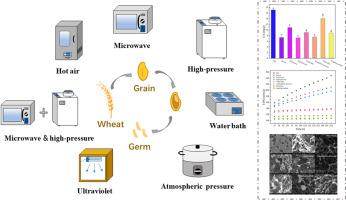用不同稳定方法处理的小麦胚芽对面团特性和馒头质量的影响
IF 3.9
2区 农林科学
Q2 FOOD SCIENCE & TECHNOLOGY
引用次数: 0
摘要
本研究对小麦胚芽采用了不同的稳定化方法(热风、微波、高压、水浴、常压、紫外线和微波加高压),以探讨它们对面团特性和馒头成品质量的影响。所有处理方案的稳定脂肪酶活性介于 14.05 至 7.24 毫克/克之间,其中紫外线处理(14.05 毫克/克)效果最差,高压处理(7.24 毫克/克)效果最好。但是,加入高压处理后,面团中小麦胚芽的β片含量增加到 27.74%,面团硬度增加,馒头的比容降低到 1.61 mL/g。热风处理提高了小麦胚芽面团的结构稳定性,α-螺旋含量和二硫键含量分别增至 29.06% 和 23.10 μmol/mg,并具有良好的发酵特性。这项研究揭示了稳定化小麦胚芽对面团加工特性和面包质量的影响,为工业生产中的小麦胚芽稳定化方法提供了解决方案。本文章由计算机程序翻译,如有差异,请以英文原文为准。

Effects of wheat germ treated with different stabilization methods on dough characteristics and steamed bread quality
In this study, different stabilization methods (hot air, microwave, high-pressure, water bath, atmospheric pressure, ultraviolet, and microwave coupled with high-pressure) were applied to wheat germ to explore their impacts on the dough characteristics and quality of the steamed bread end-product. The stabilized lipase activity for all treatment schemes ranged from 14.05 to 7.24 mg/g, with the ultraviolet treatment (14.05 mg/g) being the least effective and high-pressure treatment (7.24 mg/g) being the most effective. However, the addition of high-pressure treatment increased the β-sheets content of wheat germ in the dough to 27.74%, increased dough hardness, and decreased the specific volume of the steamed bread to 1.61 mL/g. Hot air treatment improved the structural stability of the wheat germ dough, and the α-helix content and disulfide bond content increased to 29.06% and 23.10 μmol/mg, respectively, with good fermentation characteristics. This study reveals the impact of stabilized wheat germ on the dough's processing characteristics and the bread's quality, providing solutions for wheat germ stabilization methods in industrial production.
求助全文
通过发布文献求助,成功后即可免费获取论文全文。
去求助
来源期刊

Journal of Cereal Science
工程技术-食品科技
CiteScore
7.80
自引率
2.60%
发文量
163
审稿时长
38 days
期刊介绍:
The Journal of Cereal Science was established in 1983 to provide an International forum for the publication of original research papers of high standing covering all aspects of cereal science related to the functional and nutritional quality of cereal grains (true cereals - members of the Poaceae family and starchy pseudocereals - members of the Amaranthaceae, Chenopodiaceae and Polygonaceae families) and their products, in relation to the cereals used. The journal also publishes concise and critical review articles appraising the status and future directions of specific areas of cereal science and short communications that present news of important advances in research. The journal aims at topicality and at providing comprehensive coverage of progress in the field.
 求助内容:
求助内容: 应助结果提醒方式:
应助结果提醒方式:


